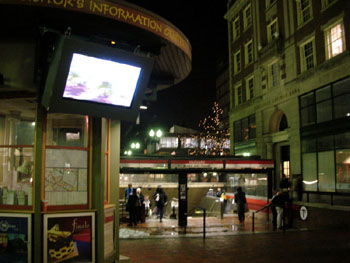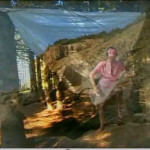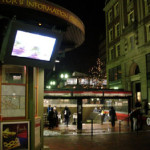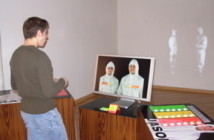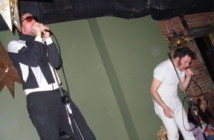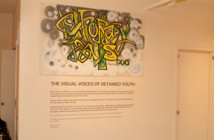February brings a (free) looped screening of works by video art titans Francis Alys, David Claerbout, Joan Jonas, Isaac Julien, William Kentridge, Pipilotti Rist, and Anri Sala to Harvard Square. Just pop out of the T station at the exit by the pit and look up to the information kiosk roof. You will see a 42-inch plasma television, where, about fifty percent of the time, a short video piece will be underway. And if you step closer, to just under the display, you can hear the audio. Linger a bit with your neck craned in rapt attention, and you can witness the work nearly fully. A few are fairly mesmerizing. All were initially presented at New York’s The New Museum in 2003, part of the “Point of View” exhibit.
The other fifty percent of the time, rapid-fire ads for area business silently roll by. These are snappily designed plugs for the Harvard Book Store, the A.R.T., Grendel’s, the Brattle, Harding House B&B, and even the formerly flamboyantly down-market Hong Kong restaurant/bar/comedy club. Behind every spot is the same creative team: Lumen Eclipse. It shows. Each design package includes a few tasteful logos and fonts dancing against appropriated imagery, Flash-style. A few years ago “Lumen Eclipse” was the name of a series of evenings where “media artists” presented work at Rivergods, a cozy but hip bar in Cambridgeport. Now - and I take this straight from their media kit - the company/persona “Lumen Eclipse” will continue to host trendsetting events such as these, all on top of their Harvard Square kiosk venture and design work, all predicated on probing the “dialogue between commerce and art.”
In Harvard Square, a simulation of that kind of dialogue is presented almost chivalrously. After Anri Sala’s incredibly subtle Time after Time concludes and rolls credits, several minutes of silent commercials follow. Those spots then yield the floor to the circling, barking dogs of Francis Alÿs’s El Gringo. The idea is that Lumen Eclipse’s two plasma televisions are passed daily by more than 50,000 walking consumers. A cut of the advertising dollars from businesses who desire to reach that disposable income is then dedicated to presenting interesting work by worthy artists to that same public. And even though February’s fare is far from site specific, there have even been calls for paid video commissions of local work (where local may mean work by artists who live in the area, or work by far flung artists who take Cambridge as a theme). The project’s vision is a happy cohabitation of approximate independence: the public within Harvard’s orbit does a good job supporting the economy, and so the bustling economy is painlessly leveraged to pay artists, and to provide a lusciously large and public digital canvas for subsequent work.
I am disappointed, however, that it is all so unobtrusive. The displays are far too high above anyone’s line of sight. I didn’t notice them for several months. The sound on the video pieces was, I think, deliberately engineered to be ignored by busy commuters and tourists. You have to seek the sweet spot directly below the screens. During daylight hours, there is a lot of glare and dust. I wanted to really watch the videos but found that I could not. And as far as advertising dollars go, I imagine that businesses would prefer a better chance at grabbing the attention of some proportion of the 50,000 pairs of potential eyes. Sure, when Sovereign Bank unveiled an outdoor digital display of continuously perky, hominid employees who actually called out to passers-by [are these at other Sovereign banks too?], I was delighted to note the display had a fist-sized hole in it within a week. But here, the imagery does not even get the chance to provoke a visceral reaction. The displays rise above all that, smug in their conceptual appeal and weak in their emotional one. (I should admit that I suspect Pipilotti Rist’s I Want to See How You See, a fluorescent tour of decadent scenes including tropical flowers, babies, and regressed female vocals, did provide late-night mind-bending to Harvard students.)
For me, the best part of the Lumen Eclipse package was their website, where I was able check out these videos in their entirety. My favorite was Waltz, by Joan Jonas. In it, a cast of five enacts a series of scenes in saturated color, and with a sort of homespun pomp. The soundtrack is a haunting fiddle going about the grim business of coaxing a musical reel from a very old instrument, overlaid with the rumblings of a faraway storm, or the ocean, or the loud crunching of someone walking on stones. Two masked and thick-ankled women waved flags, one a dilapidated white flag in a clearing, and the other, a red flag against a rocky shore. Two men, one black and one white, circled a tree in oddly schlumpy casual wear. Someone arranged a spread of driftwood, circular mirrors, and other talismans. A white dog occasionally enters the frame. From time to time, a slightly awkward magic moment was enacted; either a woman disappeared with a quiet bang, or a chair levitated. Jonas did not try to hide the tricks of these shots. In no way were the costumes, props, or even the sunny outdoor settings transcendent. What Waltz was, it seemed to me, was a loving, video fetish of the motley business of trying to be transcendent. This, I suppose, is the aim of art and advertising too. I did try to return to Harvard Square to view the piece in situ with a mind to art and commerce, but I never caught that it before losing patience with the ad loop. In this case, I prefer the privacy of my overheated office, squinting at the screen with the sound turned all the way up (and without the damn commercials!).
Links:
Lumen Eclipse
"Lumen Eclipse" is on view at the Harvard Square information kiosk.
All images are courtesy of the artist and Lumen Eclipse.

